
Click the blue text above to follow us



Author’s Note
🔊 Author Introduction: A graduate student from a 985 university, a researcher in the field of Matlab;
🚅SeatRightInscription:行百里者,半于九十。
✅Research Scope: Complete Code, Paper Reproduction, Program Customization, Journal Writing, Research Cooperation
🏆CodeAcquisitionMethod:How to Obtain Matlab Code for Solar Cell Simulation
For more Matlab physical application simulation content, click below👇
Matlab Physical Applications (Advanced Version)
Matlab Physical Applications (Milk Tea Price Version)


Preface
📋📋📋 The table of contents is as follows: 🎁🎁🎁
Contents
💥1 Overview
📚2 Code and Running Steps
🎉3 Running Results
🌈4 Matlab Version and References
🔎5 Code Acquisition Method
🍅6 Simulation Consulting



1 Overview
Drift-Diffusion of Solar Cells
The principle and process of drift-diffusion in solar cells refer to the movement of photogenerated carriers from the light absorption region to the electrodes under the influence of an electric field. Below is the general process of drift-diffusion in solar cells:
1 Light Absorption: Solar cells are typically made of semiconductor materials, such as silicon. When light strikes the light absorption area of the cell, photons are absorbed by the semiconductor material, exciting electrons to jump from the valence band to the conduction band, forming electron-hole pairs.
2 Separation: The process of separating photogenerated carriers (electrons and holes) is accomplished through a “pn junction” or “heterojunction”. In the p-type semiconductor region, holes are the majority carriers, while in the n-type semiconductor region, electrons are the majority carriers. Therefore, when there is a pn junction or heterojunction in the cell, photogenerated carriers will be separated into different carrier regions.
3 Drift: Once the photogenerated carriers are separated, they will be driven by the electric field force. Since the p-type region has a positive charge and the n-type region has a negative charge, electrons will drift towards the n-type region while holes will drift towards the p-type region. This process is called drift.
4 Diffusion: In addition to the electric field effect, diffusion is also an important mechanism for the movement of photogenerated carriers. Due to thermal motion of electrons and holes, they will diffuse randomly. This diffusion process causes photogenerated carriers to spread from regions of high concentration to regions of low concentration.
5 Electrode Collection: Finally, electrons and holes will be collected by their respective electrodes. In solar cells, the positive electrode is generally located in the p-type semiconductor region, while the negative electrode is located in the n-type semiconductor region. When photogenerated carriers reach the electrodes, they are absorbed by the electrodes, thus forming a current.
In summary, the principle of drift-diffusion in solar cells involves processes such as light absorption, separation, drift, and diffusion to convert light energy into electrical energy. This process requires a well-designed structure and materials for solar cells to improve the separation efficiency of photogenerated carriers and the mobility of electrons, thereby achieving higher solar energy conversion efficiency.

2 Code and Running Steps
(1) Directly run main.m to generate the graph with one click.

3Running Results
3Running Results
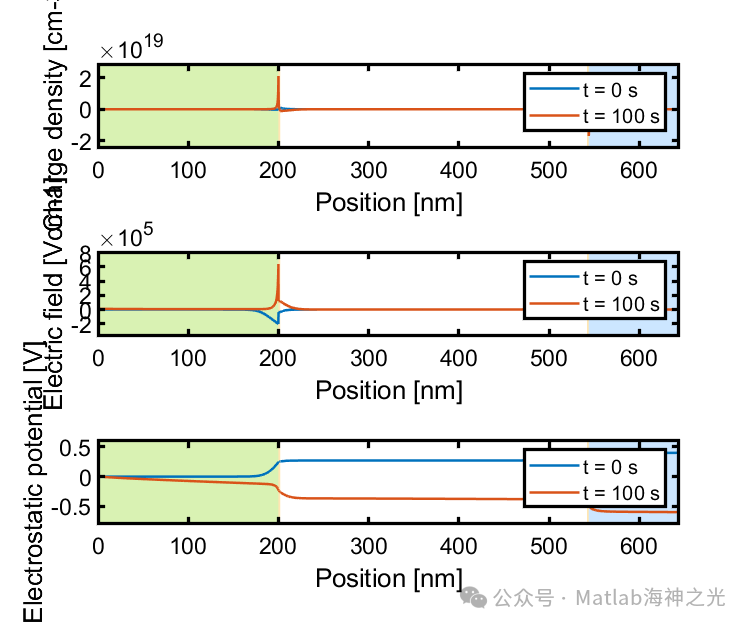
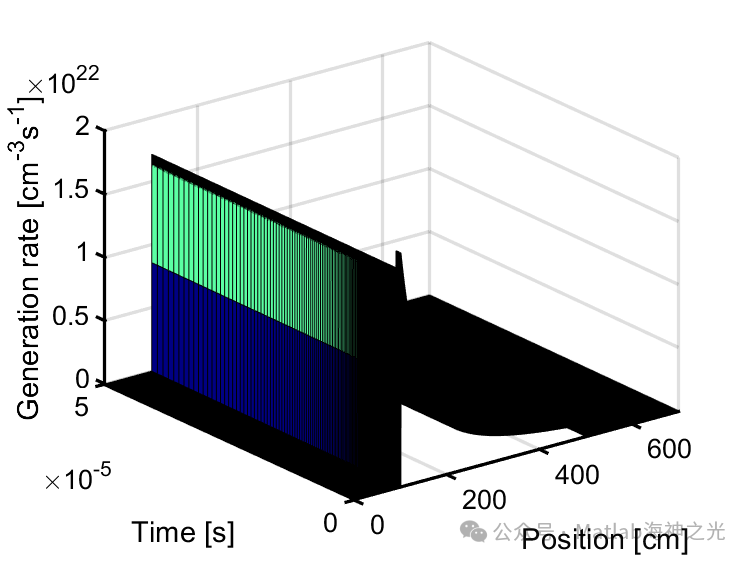
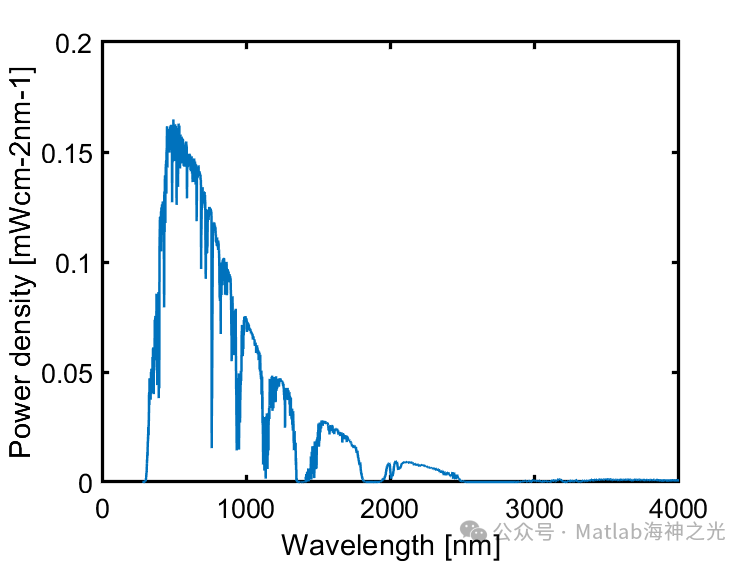
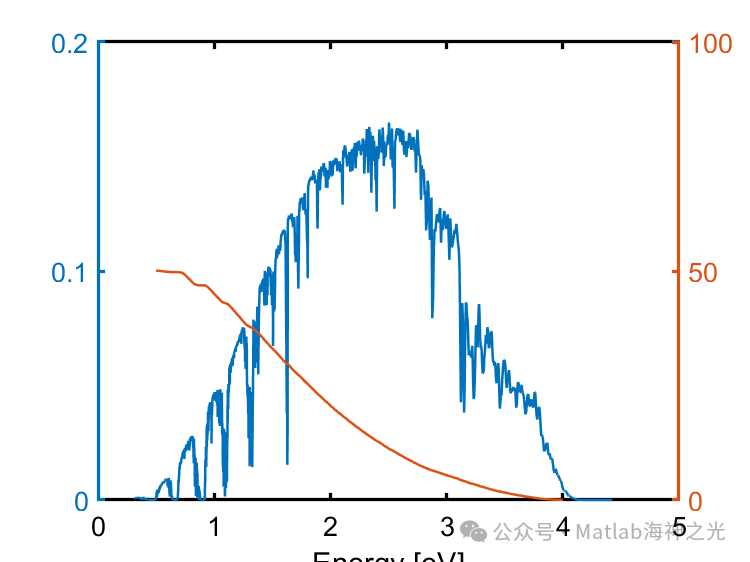
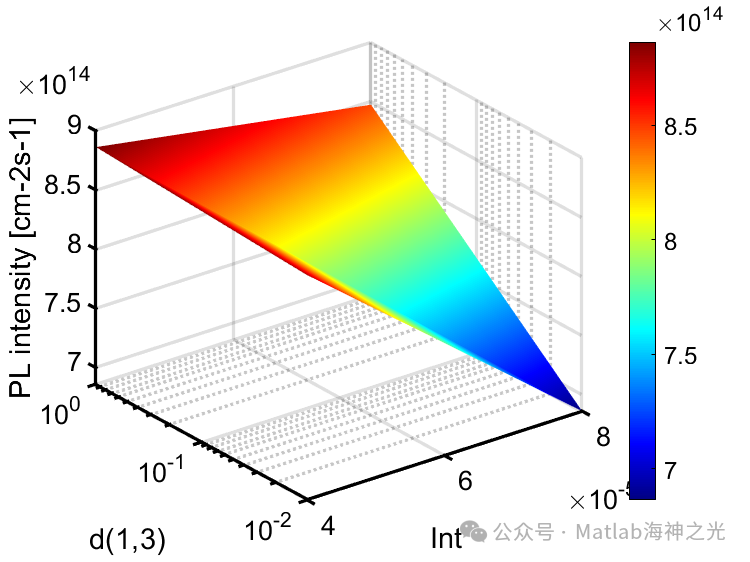
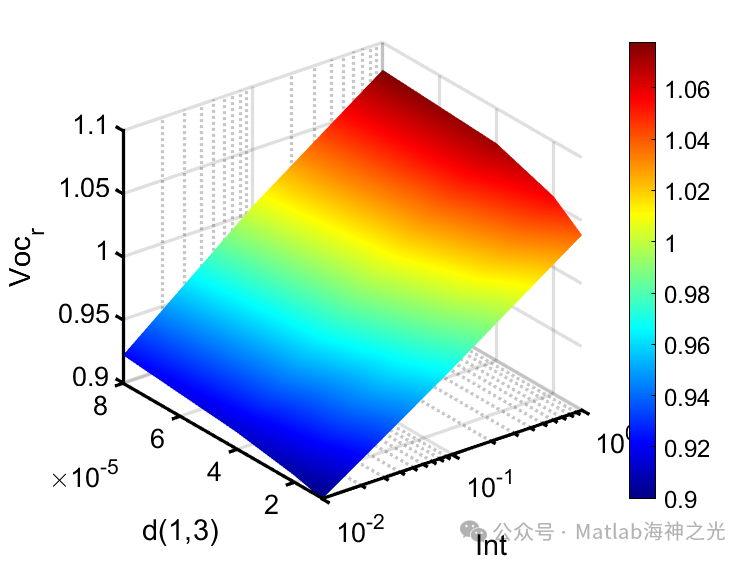
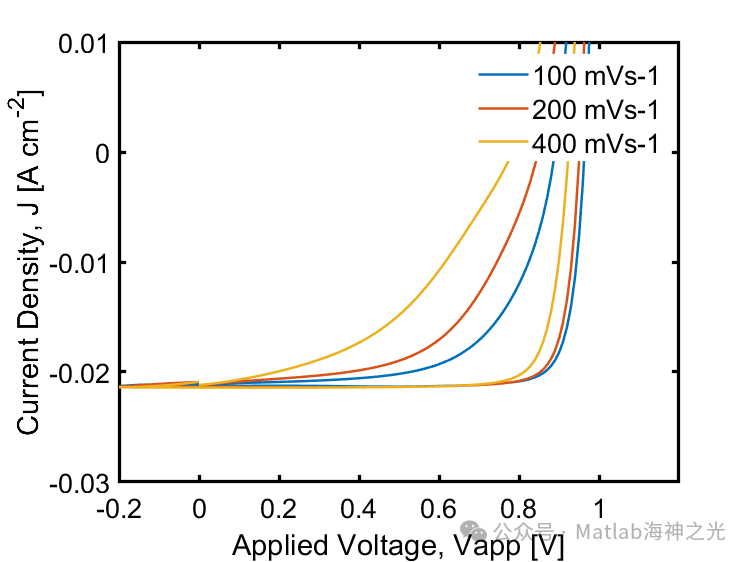
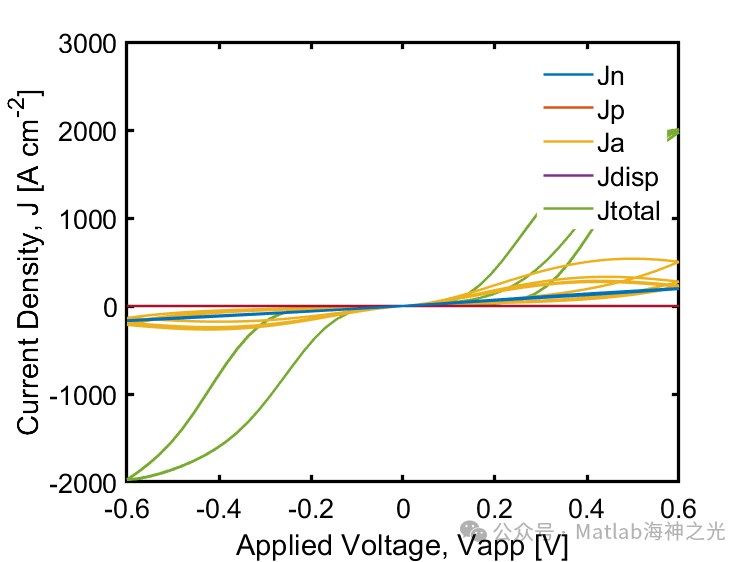
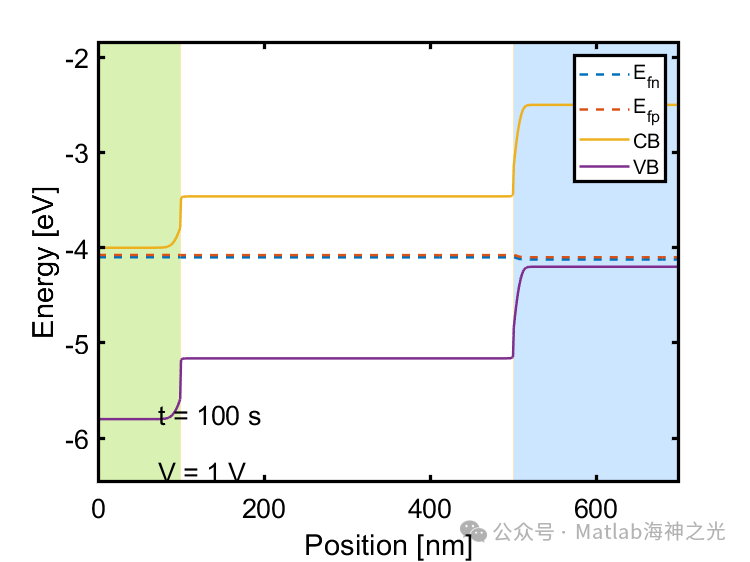

4Matlab Version and References
1 Matlab Version
2019b
2 References
[1] Men Yunge. MATLAB Physical Computing and Visualization [M]. Tsinghua University Press, 2013.
3 Note
This section is extracted from the Internet for reference only. If there is any infringement, please contact for deletion.


5 Code Acquisition Method
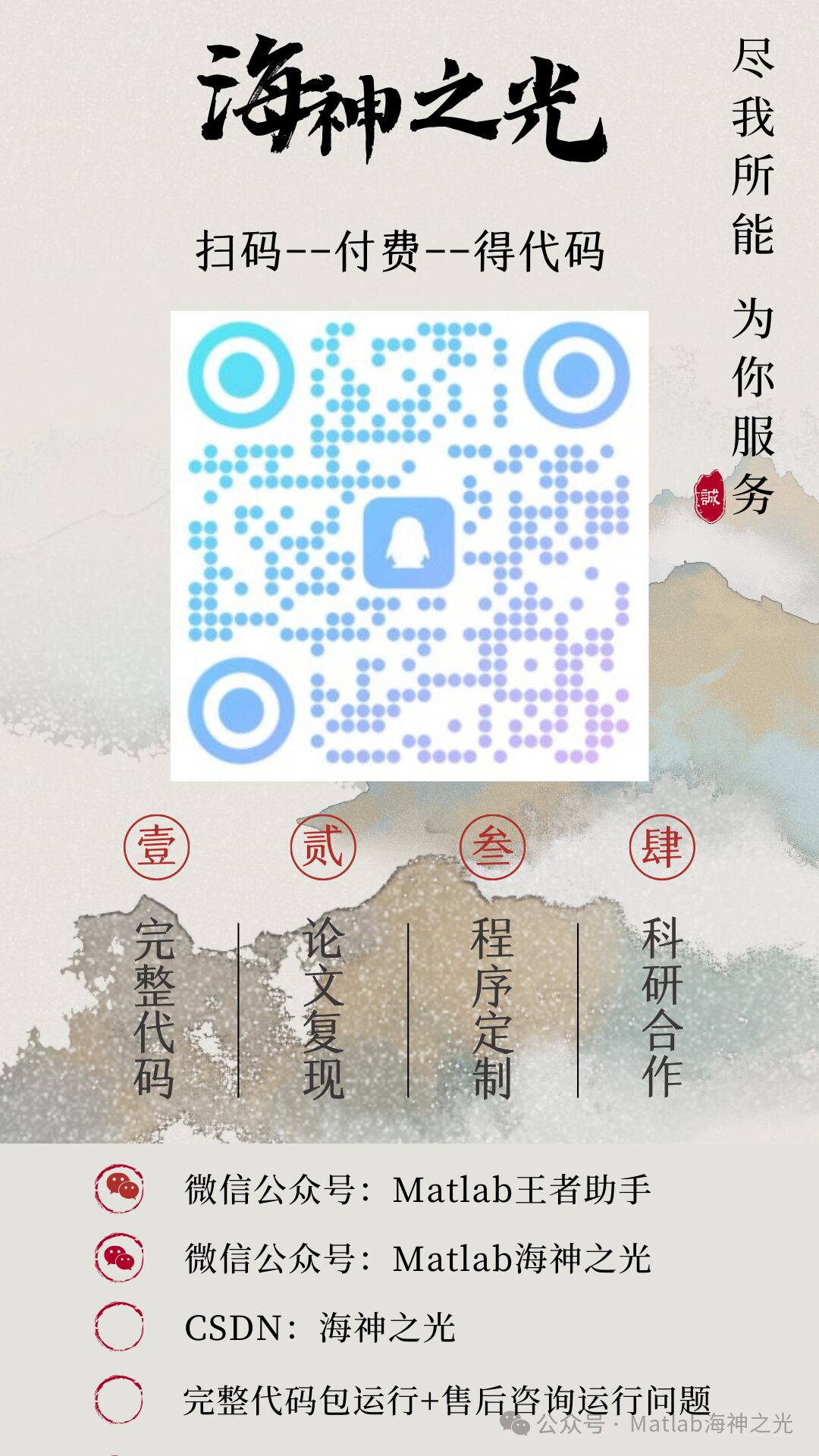

6 Simulation Consulting
**🍅 Simulation Consulting
1 Various Intelligent Optimization Algorithms Improvement and Application**
1.1 PID Optimization
1.2 VMD Optimization
1.3 Distribution Network Reconstruction
1.4 Three-Dimensional Packing
1.5 Microgrid Optimization
1.6 Layout Optimization
1.7 Parameter Optimization
1.8 Cost Optimization
1.9 Charging Optimization
1.10 Scheduling Optimization
1.11 Price Optimization
1.12 Departure Optimization
1.13 Distribution Optimization
1.14 Coverage Optimization
1.15 Control Optimization
1.16 Inventory Optimization
1.17 Routing Optimization
1.18 Design Optimization
1.19 Location Optimization
1.20 Absorption Optimization
1.21 Site Selection Optimization
1.22 Operation Optimization
1.23 Assignment Optimization
1.24 Combination Optimization
1.25 Workshop Scheduling
1.26 Production Scheduling
1.27 Economic Scheduling
1.28 Assembly Line Scheduling
1.29 Reservoir Scheduling
1.30 Slot Optimization
1.31 Bus Scheduling Optimization
1.32 Container Ship Loading Optimization
1.33 Pump Combination Optimization
1.34 Medical Resource Allocation Optimization
1.35 Visual Field Base Station and Drone Location Optimization
**2 Machine Learning and Deep Learning Classification and Prediction**
**2.1 Machine Learning and Deep Learning Classification**
2.1.1 BiLSTM Bidirectional Long Short-Term Memory Neural Network Classification
2.1.2 BP Neural Network Classification
2.1.3 CNN Convolutional Neural Network Classification
2.1.4 DBN Deep Belief Network Classification
2.1.5 DELM Deep Learning Extreme Learning Machine Classification
2.1.6 ELMAN Recurrent Neural Network Classification
2.1.7 ELM Extreme Learning Machine Classification
2.1.8 GRNN General Regression Neural Network Classification
2.1.9 GRU Gated Recurrent Unit Classification
2.1.10 KELM Hybrid Kernel Extreme Learning Machine Classification
2.1.11 KNN Classification
2.1.12 LSSVM Least Squares Support Vector Machine Classification
2.1.13 LSTM Long Short-Term Memory Network Classification
2.1.14 MLP Multi-Layer Perceptron Classification
2.1.15 PNN Probabilistic Neural Network Classification
2.1.16 RELM Robust Extreme Learning Machine Classification
2.1.17 RF Random Forest Classification
2.1.18 SCN Stochastic Configuration Network Model Classification
2.1.19 SVM Support Vector Machine Classification
2.1.20 XGBOOST Classification
**2.2 Machine Learning and Deep Learning Prediction**
2.2.1 ANFIS Adaptive Neuro-Fuzzy Inference System Prediction
2.2.2 ANN Artificial Neural Network Prediction
2.2.3 ARMA Autoregressive Moving Average Model Prediction
2.2.4 BF Particle Filter Prediction
2.2.5 BiLSTM Bidirectional Long Short-Term Memory Neural Network Prediction
2.2.6 BLS Broad Learning System Prediction
2.2.7 BP Neural Network Prediction
2.2.8 CNN Convolutional Neural Network Prediction
2.2.9 DBN Deep Belief Network Prediction
2.2.10 DELM Deep Learning Extreme Learning Machine Prediction
2.2.11 DKELM Regression Prediction
2.2.12 ELMAN Recurrent Neural Network Prediction
2.2.13 ELM Extreme Learning Machine Prediction
2.2.14 ESN Echo State Network Prediction
2.2.15 FNN Feedforward Neural Network Prediction
2.2.16 GMDN Prediction
2.2.17 GMM Gaussian Mixture Model Prediction
2.2.18 GRNN General Regression Neural Network Prediction
2.2.19 GRU Gated Recurrent Unit Prediction
2.2.20 KELM Hybrid Kernel Extreme Learning Machine Prediction
2.2.21 LMS Least Mean Squares Algorithm Prediction
2.2.22 LSSVM Least Squares Support Vector Machine Prediction
2.2.23 LSTM Long Short-Term Memory Network Prediction
2.2.24 RBF Radial Basis Function Neural Network Prediction
2.2.25 RELM Robust Extreme Learning Machine Prediction
2.2.26 RF Random Forest Prediction
2.2.27 RNN Recurrent Neural Network Prediction
2.2.28 RVM Relevance Vector Machine Prediction
2.2.29 SVM Support Vector Machine Prediction
2.2.30 TCN Temporal Convolutional Network Prediction
2.2.31 XGBoost Regression Prediction
2.2.32 Fuzzy Prediction
2.2.33 Singular Spectrum Analysis Method SSA Time Series Prediction
**2.3 Machine Learning and Deep Learning Practical Application Prediction**
CPI Index Prediction, PM2.5 Concentration Prediction, SOC Prediction, Financial Warning Prediction, Yield Prediction, Parking Space Prediction, Pest Prediction, Steel Thickness Prediction, Battery Health Status Prediction, Power Load Prediction, Housing Price Prediction, Corrosion Rate Prediction, Fault Diagnosis Prediction, Photovoltaic Power Prediction, Trajectory Prediction, Aircraft Engine Life Prediction, Exchange Rate Prediction, Concrete Strength Prediction, Heating Furnace Temperature Prediction, Price Prediction, Traffic Flow Prediction, Resident Consumption Index Prediction, Air Quality Prediction, Grain Temperature Prediction, Temperature Prediction, Clean Water Value Prediction, Unemployment Rate Prediction, Electricity Consumption Prediction, Transport Volume Prediction, Manufacturing Purchasing Managers Index Prediction
**3 Image Processing**
**3.1 Image Edge Detection**
**3.2 Image Processing**
**3.3 Image Segmentation**
**3.4 Image Classification**
**3.5 Image Tracking**
**3.6 Image Encryption and Decryption**
**3.7 Image Retrieval**
**3.8 Image Registration**
**3.9 Image Stitching**
**3.10 Image Evaluation**
**3.11 Image Denoising**
**3.12 Image Fusion**
**3.13 Image Recognition**
3.13.1 Dial Recognition
3.13.2 Lane Line Recognition
3.13.3 Vehicle Counting
3.13.4 Vehicle Recognition
3.13.5 License Plate Recognition
3.13.6 Parking Space Recognition
3.13.7 Size Detection
3.13.8 Answer Sheet Recognition
3.13.9 Appliance Recognition
3.13.10 Fall Detection
3.13.11 Animal Recognition
3.13.12 QR Code Recognition
3.13.13 Invoice Recognition
3.13.14 Clothing Recognition
3.13.15 Chinese Character Recognition
3.13.16 Traffic Light Recognition
3.13.17 Iris Recognition
3.13.18 Fire Detection
3.13.19 Disease Classification
3.13.20 Traffic Sign Recognition
3.13.21 Card Number Recognition
3.13.22 Mask Recognition
3.13.23 Crack Detection
3.13.24 Target Tracking
3.13.25 Fatigue Detection
3.13.26 Flag Recognition
3.13.27 Grass Recognition
3.13.28 Face Recognition
3.13.29 Renminbi Recognition
3.13.30 ID Card Recognition
3.13.31 Gesture Recognition
3.13.32 Digit and Letter Recognition
3.13.33 Palm Recognition
3.13.34 Leaf Recognition
3.13.35 Fruit Recognition
3.13.36 Barcode Recognition
3.13.37 Temperature Detection
3.13.38 Defect Detection
3.13.39 Chip Detection
3.13.40 Behavior Recognition
3.13.41 Verification Code Recognition
3.13.42 Medicinal Material Recognition
3.13.43 Coin Recognition
3.13.44 Postal Code Recognition
3.13.45 Card Recognition
3.13.46 Fingerprint Recognition
**3.14 Image Restoration**
**3.15 Image Compression**
**3.16 Image Steganography**
**3.17 Image Enhancement**
**3.18 Image Reconstruction**
**4 Path Planning**
**4.1 Traveling Salesman Problem (TSP)**
4.1.1 Single Traveling Salesman Problem (TSP)
4.1.2 Multiple Traveling Salesman Problem (MTSP)
**4.2 Vehicle Routing Problem (VRP)**
4.2.1 Vehicle Routing Problem (VRP)
4.2.2 Capacity-Constrained Vehicle Routing Problem (CVRP)
4.2.3 Capacity + Time Window + Distance Vehicle Routing Problem (DCTWVRP)
4.2.4 Capacity + Distance Vehicle Routing Problem (DCVRP)
4.2.5 Distance-Constrained Vehicle Routing Problem (DVRP)
4.2.6 Charging Station + Time Window Vehicle Routing Problem (ETWVRP)
4.2.3 Vehicle Routing Problem with Multiple Capacities (MCVRP)
4.2.4 Distance-Constrained Multi-Vehicle Routing Problem (MDVRP)
4.2.5 Vehicle Routing Problem with Simultaneous Pickup and Delivery (SDVRP)
4.2.6 Time Window + Capacity Vehicle Routing Problem (TWCVRP)
4.2.6 Time Window Vehicle Routing Problem (TWVRP)
**4.3 Multimodal Transport Problem**
**4.4 Robot Path Planning**
4.4.1 Obstacle Avoidance Path Planning
4.4.2 Maze Path Planning
4.4.3 Grid Map Path Planning
**4.5 Delivery Path Planning**
4.5.1 Cold Chain Delivery Path Planning
4.5.2 Takeaway Delivery Path Planning
4.5.3 Mask Delivery Path Planning
4.5.4 Medicine Delivery Path Planning
4.5.5 Delivery Path Planning with Charging Station
4.5.6 Chain Supermarket Delivery Path Planning
4.5.7 Vehicle Collaborative Drone Delivery Path Planning
**4.6 Drone Path Planning**
4.6.1 Aircraft Simulation
4.6.2 Drone Flight Operations
4.6.3 Drone Trajectory Tracking
4.6.4 Drone Swarm Simulation
4.6.5 Three-Dimensional Drone Path Planning
4.6.6 Drone Formation
4.6.7 Drone Collaborative Tasks
4.6.8 Drone Task Assignment
**5 Voice Processing**
**5.1 Voice Emotion Recognition**
**5.2 Sound Source Localization**
**5.3 Feature Extraction**
**5.4 Voice Coding**
**5.5 Voice Processing**
**5.6 Voice Separation**
**5.7 Voice Analysis**
**5.8 Voice Synthesis**
**5.9 Voice Encryption**
**5.10 Voice Denoising**
**5.11 Voice Recognition**
**5.12 Voice Compression**
**5.13 Voice Hiding**
**6 Cellular Automata**
**6.1 Cellular Automata Virus Simulation**
**6.2 Cellular Automata Urban Planning**
**6.3 Cellular Automata Traffic Flow**
**6.4 Cellular Automata Gas**
**6.5 Cellular Automata Personnel Evacuation**
**6.6 Cellular Automata Forest Fire**
**6.7 Cellular Automata Game of Life**
**7 Signal Processing**
**7.1 Fault Signal Diagnosis Analysis**
7.1.1 Gear Damage Identification
7.1.2 Asynchronous Motor Rotor Broken Bar Fault Diagnosis
7.1.3 Rolling Element Inner and Outer Ring Fault Diagnosis Analysis
7.1.4 Motor Fault Diagnosis Analysis
7.1.5 Bearing Fault Diagnosis Analysis
7.1.6 Gearbox Fault Diagnosis Analysis
7.1.7 Three-Phase Inverter Fault Diagnosis Analysis
7.1.8 Diesel Engine Fault Diagnosis
**7.2 Radar Communication**
7.2.1 FMCW Simulation
7.2.2 GPS Anti-Jamming
7.2.3 Radar LFM
7.2.4 Radar MIMO
7.2.5 Radar Angle Measurement
7.2.6 Radar Imaging
7.2.7 Radar Positioning
7.2.8 Radar Echo
7.2.9 Radar Detection
7.2.10 Radar Digital Signal Processing
7.2.11 Radar Communication
7.2.12 Radar Phased Array
7.2.13 Radar Signal Analysis
7.2.14 Radar Early Warning
7.2.15 Radar Pulse Compression
7.2.16 Antenna Radiation Pattern
7.2.17 Radar Clutter Simulation
**7.3 Biological Electrical Signals**
7.3.1 Electromyography EMG
7.3.2 Electroencephalography EEG
7.3.3 Electrocardiography ECG
7.3.4 Heart Simulation
**7.4 Communication Systems**
7.4.1 DOA Estimation
7.4.2 LEACH Protocol
7.4.3 Encoding and Decoding
7.4.4 Variational Mode Decomposition
7.4.5 Ultra-Wideband Simulation
7.4.6 Multipath Fading Simulation
7.4.7 Cellular Networks
7.4.8 Pipeline Leakage
7.4.9 Empirical Mode Decomposition
7.4.10 Filter Design
7.4.11 Analog Signal Transmission
7.4.12 Analog Signal Modulation
7.4.13 Digital Baseband Signals
7.4.14 Digital Channels
7.4.15 Digital Signal Processing
7.4.16 Digital Signal Transmission
7.4.17 Digital Signal Denoising
7.4.18 Underwater Acoustic Communication
7.4.19 Communication Simulation
7.4.20 Wireless Transmission
7.4.21 Bit Error Rate Simulation
7.4.22 Modern Communication
7.4.23 Channel Estimation
7.4.24 Signal Detection
7.4.25 Signal Fusion
7.4.26 Signal Recognition
7.4.27 Compressed Sensing
7.4.28 Noise Simulation
7.4.29 Noise Interference
**7.5 Drone Communication**
**7.6 Wireless Sensor Localization and Layout**
7.6.1 WSN Localization
7.6.2 Height Estimation
7.6.3 Filtering and Tracking
7.6.4 Target Localization
7.6.4.1 Dv-Hop Localization
7.6.4.2 RSSI Localization
7.6.4.3 Intelligent Algorithm Optimization Localization
7.6.5 Combined Navigation
**8 Power System**
Microgrid Optimization, Reactive Power Optimization, Distribution Network Reconstruction, Energy Storage Configuration